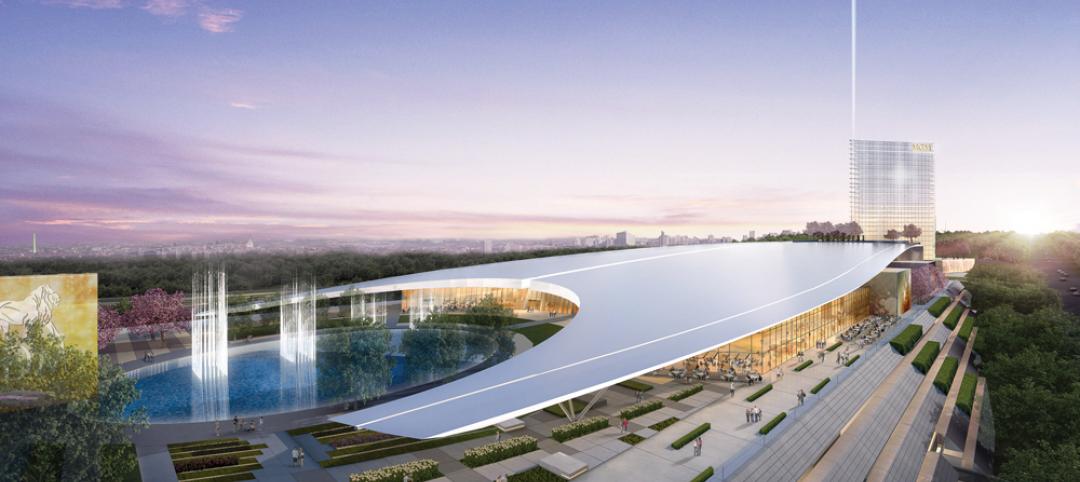As coastal flooding becomes the "new normal," many shoreline cities are trying to find long-term strategies to cope with extreme weather events. In order to advance understanding of this issue, The Boston Harbor Association teamed up with Sasaki Associates to produce Preparing for the Rising Tide, a series of reports focusing on Boston and rising sea levels.
Volume Two of this series was published in August 2014, and focuses on Designing with Water for flood management. According to the report, this school of thought "considers coastal flooding not only a threat, but an opportunity to address multiple goals while making necessary new investments in our buildings, communities, and infrastructure."
The new report contains 12 case studies of cities around the world that have applied advanced flood management techniques. In these case studies, five key design principles emerged:
1. Design for resilience. Resilience implies adapting to or bouncing back from a disturbance quickly. Resilient planning and design incorporates redundancy and anticipates change over time.
2. Create double-duty solutions. Double-duty solutions provide multiple benefits to maximize economic, ecologic, and cultural gain.
3. Strengthen community resilience. Community resilience maintains and enhances the cultural identity that defines a city through resiliency networks and social support systems. Strategies that strengthen social resilience can both cost less and provide meaningful benefits to participants.
4. Incentivize and institutionalize preparedness. Citywide and regional adaptation plans are necessary to guide resiliency efforts. Insurance standards, zoning laws, construction codes, and policy are tools that local and state governments should consider to encourage adaptation within their communities.
5. Phase plans over time. Designing with Water requires design and planning for flexibility and adaptability over time. Planning efforts that address sea level rise should be phased and have the ability to change based on external conditions.
The report concludes with recommended courses of action for members of both the private and public sectors. Here are some of the recommendations that we found particularly interesting:
Recommendations for the Private Sector:
-
Create time-phased preparedness plans based on environmental triggers such as sea level or storm intensity to maintain or even reduce risk of flood damage over time. Incorporate flood preparedness into capital maintenance schedules to minimize additional costs.
-
Look for opportunities to combine flood control with other business and institutional goals such as energy efficiency, sustainability, and livability. Coordinate such strategies with neighboring properties to provide more effective, less costly solutions.
-
Develop and teach curricula focused on Designing with Water and other flood preparedness concepts. Local design schools could be a resource.
Recommendations for the Public Sector:
-
In order to limit costly delays, dead-end investments, and exacerbated social inequalities, we strongly recommend the city of Boston and surrounding communities develop a phased master plan that protects our people and places over time as the tide rises.
-
Work with surrounding municipalities—especially those closely connected through transportation, power, water, and sewage—to develop the political will, regional planning, and resources needed to prepare for chronic coastal flooding.
-
Secure significant new public and private investment to implement the master plan and accelerate private actions. Identify an appropriate coordinating body to manage these resources most effectively to address multiple goals.
Read the full report here.
Related Stories
| Apr 9, 2014
Gregory Hodkinson appointed head of Arup Group
Hodkinson has spent his professional career at Arup and brings more than 40 years' experience in large-scale projects to the new role, including several in the US and Canada.
| Apr 9, 2014
5 important trends shaping today’s hotel construction market
AEC firms, developers, and investors worldwide are bullish on hotels. Our hospitality Giants share what’s new in this fast-morphing sector.
| Apr 9, 2014
Steel decks: 11 tips for their proper use | BD+C
Building Teams have been using steel decks with proven success for 75 years. Building Design+Construction consulted with technical experts from the Steel Deck Institute and the deck manufacturing industry for their advice on how best to use steel decking.
| Apr 8, 2014
Gehry, Foster unveil plans for Battersea Power Station redevelopment [slideshow]
Phase 3 of the massive redevelopment of the London landmark will include more than 1,300 residential units, a 160-room hotel, and 350,000 sf of retail space.
| Apr 8, 2014
Fire resistive curtain wall helps The Kensington meet property line requirements
The majority of fire rated glazing applications occur inside a building to allow occupants to exit the building safely or provide an area of refuge during a fire. But what happens when the threat of fire comes from the outside? This was the case for The Kensington, a mixed-use residential building in Boston.
| Apr 8, 2014
First look: Zaha Hadid reveals design for dreamy sculptural hotel
Hadid's design, which will become the fifth hotel tower in the City of Dreams entertainment hub in Macau, features a latticed exoskeleton enveloping the building's exterior.
| Apr 8, 2014
Understanding value billing vs. conventional billing
Every company is a sum of the value it delivers to its clients. What differs from one company to the next is how that value is delivered and perceived. All too often, it is based solely on the fee you charge.
| Apr 8, 2014
Science, engineering find common ground on the Northeastern University campus [slideshow]
The new Interdisciplinary Science and Engineering Building is designed to maximize potential of serendipitous meetings between researchers.
| Apr 8, 2014
40 Under 40 winners: Meet the contractors
Of the up-and-coming AEC professionals to be named to the class of 2014, nine make their living as contractors.
| Apr 7, 2014
40 Under 40 winners: Meet the architects
Of the up-and-coming AEC professionals to be named 40 Under 40 winners by the editors of Building Design+Construction, 21 make their living in the architecture profession.

















